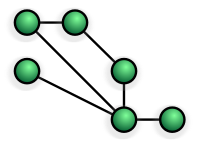A mesh network is a local area network topology in which the infrastructure nodes (i.e. bridges, switches, and other infrastructure devices) connect directly, dynamically and non-hierarchically to as many other nodes as possible and cooperate with one another to efficiently route data to and from clients.
This lack of dependency on one node allows for every node to participate in the relay of information. Mesh networks dynamically self-organize and self-configure, which can reduce installation overhead. The ability to self-configure enables dynamic distribution of workloads, particularly in the event a few nodes should fail. This in turn contributes to fault-tolerance and reduced maintenance costs.[1]
Mesh topology may be contrasted with conventional star/tree local network topologies in which the bridges/switches are directly linked to only a small subset of other bridges/switches, and the links between these infrastructure neighbours are hierarchical. While star-and-tree topologies are very well established, highly standardized and vendor-neutral, vendors of mesh network devices have not yet all agreed on common standards, and interoperability between devices from different vendors is not yet assured.[2]
- ^ Chawla, Meenu; Mundra, Ankit; Rakesh, Nitin; Agrawal, Akash; Ghrera, S. P. (2015). "Fault tolerance based routing approach for WMN". 2015 International Conference on Computer and Computational Sciences (ICCCS). pp. 177–182. doi:10.1109/ICCACS.2015.7361345. ISBN 978-1-4799-1818-8. S2CID 8664226.
- ^ Cilfone, Antonio; Davoli, Luca; Belli, Laura; Ferrari, Gianluigi (2019). "Wireless Mesh Networking: An IoT-Oriented Perspective Survey on Relevant Technologies". Future Internet. 11 (4): 99. doi:10.3390/fi11040099.

